By David Owen
“Annual income twenty pounds, annual expenditure nineteen pounds nineteen and six, result happiness. Annual income twenty pounds, annual expenditure twenty pounds ought and six, result misery.”
It is one of the best-known dictums in Dickens, but not one, or so one must presume, with which an awful lot of European football club chairmen are terribly familiar.
This week’s UEFA report – The European Club Footballing Landscape – released, with exquisite timing two days before stricken Portsmouth became the first English Premiership club to enter administration, contains a wealth of information, much of it calculated to set Wilkins Micawber’s alarm bells ringing.
The numbers are a little bigger than the David Copperfield character is used to, but if I tell you that annual income of the 732 European top-division clubs in 2008 was found to be €11.5 billion and their annual expenditure €12.1 billion, no doubt you can complete the sentence.
It is a sentence, moreover, that will be worth bearing in mind next week, when Deloitte publishes a new edition of its Football Money League, which ranks the 20 biggest clubs in the world by revenue.
The level of footballers’ wages is often blamed for the frequency with which clubs spend more than they earn. That is why clubs’ wage:turnover ratio is such a closely watched gauge within the industry.
With aggregate employee costs of top-flight clubs put at €7.1 billion in 2008, this ratio Europe-wide stood at a barely acceptable 62 percent.
But what truly beggars belief is that UEFA found 57 clubs – not far off 8 percent – contriving to spend more than 100 percent of their revenue on wages.
Indeed, there are four European countries – Serbia, Ukraine, Georgia and Israel – where the proportion of reported revenues of the entire top division paid out as employee costs exceeds 100 per cent.
 No wonder UEFA President Michel Platini comments that, “The many clubs across Europe that continue to operate on a sustainable basis…are finding it increasingly hard to coexist and compete with clubs that incur costs and transfer fees beyond their means and report losses year-after-year.”
No wonder UEFA President Michel Platini comments that, “The many clubs across Europe that continue to operate on a sustainable basis…are finding it increasingly hard to coexist and compete with clubs that incur costs and transfer fees beyond their means and report losses year-after-year.”
Incidentally, one of these countries – Ukraine – is home to the 2009 UEFA Cup winners, Shakhtar Donetsk.
There is, however, no club-by-club breakdown enabling readers to ascertain what Shakhtar or any other club’s wage:turnover ratio is.
Moreover, a footnote to the relevant chart observes that the Ukraine figures include net transfer activity, “which is part of reason for high ratio”.
Of course, clubs can and do use injections of capital to tide them over during the odd loss-making season.
Such contributions might come from a generous owner or other benefactor, or they might be bank loans – which brings us to the other sexy topic when club finances are put under the microscope: debt.
The report puts the amount of bank debt and commercial loans owed by top-flight clubs at €5.5 billion, but says net debt is “highly concentrated”, with English clubs containing on their balance-sheets an estimated 56 percent of Europe-wide net commercial debt.
English clubs also account, however, for an estimated 48 percent of the total value of European balance sheet fixed assets, which are put at €5.2 billion.
“One thing is clear,” the report says, “the level of bank and commercial debt is strongly connected to the size of the asset base, with long-term debt typically linked to stadium ownership.”
This is reassuring to an extent, at least as far as the broader economy is concerned: if indebted football clubs fail to service their debts, their creditors would at least have something tangible at their disposal.
And yet, when you pause to think about it, football assets are peculiar things whose true value is extremely difficult to appraise.
Take stadia: these are not like standard office-blocks or retail outlets that might interest a wide range of purchasers; they are about as specialised as it is possible for a building to be.
If a loan goes sour leaving the bank in possession of a football stadium, who on earth would they sell it to? And if no-one bar the defaulting club could find a use for it, just what is its true value?
Only if the land on which the stadium is built is attractive to property developers does valuation become easier.
Even then, it could be argued that the stadium itself had become a liability, rather than an asset, insofar as the cost of demolishing it would add to overall development costs.
And what about players? How should their value be most fairly accounted for, always recognising that a footballer’s career can be ended at any moment by a malicious or mistimed tackle?
Transfer fees do provide some guidance, but can vary enormously depending on factors that have nothing to do with footballing ability, such as the degree of desperation of buying or selling club and the length of time remaining on a player’s existing contract.
It is interesting that the UEFA report concludes that “players’ values in balance sheets are understated compared to the ‘market value’”.
However, it says that, as things stand, more than one club in three – 35 percent – reported negative equity (assets less than liabilities) in their balance sheets in 2008.
“Weak balance sheets when combined with ongoing losses and/or negative cash flows can be dangerous,” it warns.
He might phrase it more punchily, but Mr Micawber would surely concur.
The UEFA report is available here.
David Owen is a specialist sports journalist who worked for 20 years for the Financial Times in the United States, Canada, France and the UK. He ended his FT career as sports editor after the 2006 World Cup and is now freelancing, including covering last year’s Beijing Olympics. An archive of Owen’s material may be found by Twitter users at www.twitter.com/dodo938
Contact the writer of this article at zib.l1713298847labto1713298847ofdlr1713298847owedi1713298847sni@n1713298847ewo.d1713298847ivad1713298847">zib.l1713298847labto1713298847ofdlr1713298847owedi1713298847sni@n1713298847ewo.d1713298847ivad1713298847.

